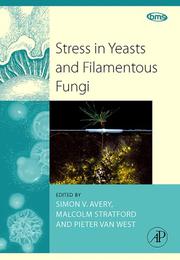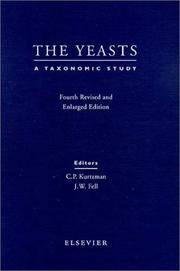| Listing 1 - 10 of 53 | << page >> |
Sort by
|
Periodical
Abstract | Keywords | Export | Availability | Bookmark
 Loading...
Loading...Choose an application
- Reference Manager
- EndNote
- RefWorks (Direct export to RefWorks)
Focuses on research on all aspects of Saccharomyces and other yeast genera. The topics covered include: genetics; genomics; molecular biology; cell and developmental biology; biochemistry; physiology; pathobiology; biotechnology; ecology; taxonomy; and evolution. Abstracts and full-text (PDF only), 1997- ; abstracts only, 1996.
gisten --- Genetics --- yeast [fungi] --- Yeasts --- Yeast --- Levure --- genetics --- Periodicals. --- Périodiques --- Yeasts. --- 582.282.23 --- 579 --- 57 --- Fungal Proteins --- Saccharomycetineae. Yeasts. Brettanomyces --- Microbiology --- Biological sciences in general --- Periodicals --- YEASTS --- Agriculture Sciences --- Agricultural Biotechnology --- periodicals --- Soil Chemistry, Microbiology, Fertility & Fertilizers --- Agriculture Sciences. --- Agricultural Biotechnology. --- periodicals. --- 579 Microbiology --- 582.282.23 Saccharomycetineae. Yeasts. Brettanomyces --- Yeast. --- genetics. --- Nematospora --- Edible fungi --- Leavening agents --- Yeast-free diet --- Levures (Botanique)

ISBN: 128103830X 9786611038304 0080551270 012374184X 9780123741844 9780080551272 6611038302 Year: 2008 Publisher: London Boston Academic Press
Abstract | Keywords | Export | Availability | Bookmark
 Loading...
Loading...Choose an application
- Reference Manager
- EndNote
- RefWorks (Direct export to RefWorks)
Yeasts and filamentous fungi need to cope with stress, whether growing in the laboratory or in the natural environment, whether victims or offenders in interactions with other organisms. These considerations are discussed in this volume that coveres stress in the broad sense, within the context of mycology.* Includes discussions of the stresses associated with organism-organism interactions and stress under controlled conditions* Anthropogenic stress towards fungi in the environment and the impacts that such stressors may have on different organisms and communities in the wild are
Yeast fungi --- Filamentous fungi --- Effect of stress on. --- Microfungi --- Molds (Fungi) --- Yeasts --- Fungi --- Basidiomycetes --- Blastomycetes --- Endomycetales

ISBN: 9780444813121 0444813128 0080542697 9780080542690 9786611038991 1281038997 Year: 2000 Publisher: Amsterdam New York
Abstract | Keywords | Export | Availability | Bookmark
 Loading...
Loading...Choose an application
- Reference Manager
- EndNote
- RefWorks (Direct export to RefWorks)
The yeasts are a phylogenetically diverse group of fungi characterized by unicellular growth. Yeasts have been used for bread making and brewing beverages for millennia, and have become increasingly important in biotechnology for production of fuel alcohol, organic acids, enzymes, and various pharmacologically important chemicals. Other species are serious human, animal, and plant pathogens. Since publication of the 3rd edition of this book in 1984, numerous new species and genera have been described, many because of the application of new molecular biological methods. Molecular comparisons
Fungi --- Yeast fungi --- Levures (Botanique) --- Champignons --- Classification. --- Classification --- Yeasts --- Basidiomycetes --- Blastomycetes --- Endomycetales
Book
Abstract | Keywords | Export | Availability | Bookmark
 Loading...
Loading...Choose an application
- Reference Manager
- EndNote
- RefWorks (Direct export to RefWorks)
This eBook is a collection of articles from a Frontiers Research Topic. Frontiers Research Topics are very popular trademarks of the Frontiers Journals Series: they are collections of at least ten articles, all centered on a particular subject. With their unique mix of varied contributions from Original Research to Review Articles, Frontiers Research Topics unify the most influential researchers, the latest key findings and historical advances in a hot research area! Find out more on how to host your own Frontiers Research Topic or contribute to one as an author by contacting the Frontiers Editorial Office: frontiersin.org/about/contact
Book
Abstract | Keywords | Export | Availability | Bookmark
 Loading...
Loading...Choose an application
- Reference Manager
- EndNote
- RefWorks (Direct export to RefWorks)
During spontaneous food/beverage fermentations, the microbiota associated with the raw material has a considerable importance: this microbial consortium evolves in reason of the nutrient content and of the physical, chemical, and biological determinants present in the food matrix, shaping fermentation dynamics with significant impacts on the ‘qualities’ of final productions. The selection from the indigenous micro-biodiversity of ‘virtuous’ ecotypes that coupled pro-technological and biotechnological aptitudes provide the basis for the formulation of ‘tailored’ starter cultures. In the fermenting food and beverage arena, the wine sector is generally characterized by the generation of a high added value. Together with a pronounced seasonality, this feature strongly contributes to the selection of a large group of starter cultures. In the last years, several studies contributed to describe the complexity of grapevine-associated microbiota using both culture-dependent and culture-independent approaches. The grape-associated microbial communities continuously change during the wine-making process, with different dominances that correspond to the main biotechnological steps that take place in wine. In order to simplify, following a time trend, four major dominances can be mainly considered: non-Saccharomyces, Saccharomyces, lactic acid bacteria (LAB), and spoilage microbes. The first two dominances come in succession during the alcoholic fermentation: the impact of Saccharomyces (that are responsible of key enological step of ethanol production) can be complemented/integrated by the contributions of compatible non-Saccharomyces strains. Lactic acid bacteria constitute the malolactic consortium responsible of malolactic fermentation, a microbial bioconversion often desired in wine (especially in red wine production). Finally, the fourth dominance, the undesired microbiota, represents a panel of microorganisms that, coupling spoilage potential to the resistance to the harsh conditions typical of wine environment, can cause important economic losses. In each of these four dominances a complex microbial biodiversity has been described. The studies on the enological significance of the micro-biodiversity connected with each of the four dominances highlighted the presence of a dichotomy: in each consortia there are species/strains that, in reason of their metabolisms, are able to improve wine ‘qualities’ (resource of interest in starter cultures design), and species/strains that with their metabolism are responsible of depreciation of wine. Articles describing new oenological impacts of yeasts and bacteria belonging to the four main categories above mentioned (non-Saccharomyces, Saccharomycetes, lactic acid bacteria, and spoilage microbes) are welcome. Moreover, in this Research Topic, we encourage mini-review submissions on topics of immediate interest in wine microbiology that link microbial biodiversity with positive/negative effects in wine.
Wine --- Yeasts --- Microbial Diversity --- Bacteria --- Safety --- alcoholic fermentation --- malolactic fermentation --- grapes --- quality
Book
ISBN: 953513678X 9535136771 9535145746 Year: 2017 Publisher: IntechOpen
Abstract | Keywords | Export | Availability | Bookmark
 Loading...
Loading...Choose an application
- Reference Manager
- EndNote
- RefWorks (Direct export to RefWorks)
Yeast-based biotechnology traditionally regards the empirical production of fermented drinks and leavened bread, processes which surprisingly keep posing challenges and fuelling research. But yeasts nowadays also provide amenable cell factories, producing bulk and fine chemicals and molecules, and are increasingly used as tools in processes as diverse as food preservation or bioremediation. Importantly, yeasts are excellent models of cell and molecular biology for higher eukaryotes, including humans, contributing with key discoveries to understand processes and diseases. All taken, yeast-related business is worth billions, critically contributing to the economical welfare of many differently developed countries. This book provides some insights into aspects of yeast science and biotechnology less frequently addressed in the literature but nonetheless decisive to improve knowledge and, accordingly, boost up yeast-based innovation.
Yeast. --- Nematospora --- Yeasts --- Edible fungi --- Leavening agents --- Yeast-free diet --- Life Sciences --- Food Technology --- Agricultural and Biological Sciences --- Bromatology
Book
ISBN: 9535136003 9535135996 9535146149 Year: 2017 Publisher: IntechOpen
Abstract | Keywords | Export | Availability | Bookmark
 Loading...
Loading...Choose an application
- Reference Manager
- EndNote
- RefWorks (Direct export to RefWorks)
Yeast - Industrial Applications is a book that covers applications and utilities of yeasts in food, chemical, energy, and environmental industries collected in 12 chapters. The use of yeasts in the production of metabolites, enzymatic applications, fermented foods, microorganism controls, bioethanol production, and bioremediation of contaminated environments is covered showing results, methodologies, and processes and describing the specific role of yeasts in them. The traditional yeast Saccharomyces cerevisiae is complemented in many applications with the use of less known non-Saccharomyces yeasts that now are being used extensively in industry. This book compiles the experience and know-how of researchers and professors from international universities and research centers.
Yeast. --- Nematospora --- Yeasts --- Edible fungi --- Leavening agents --- Yeast-free diet --- Life Sciences --- Food Technology --- Agricultural and Biological Sciences --- Bromatology
Periodical
ISSN: 0253651X 23835249 Year: 1972 Publisher: Seoul, Korea : Seoul, Korea : Han'guk Kyunhakhoe 한국 균학회
Abstract | Keywords | Export | Availability | Bookmark
 Loading...
Loading...Choose an application
- Reference Manager
- EndNote
- RefWorks (Direct export to RefWorks)
Fungi --- Korea --- dead periodical --- societies --- Life Sciences --- Biology --- Botany --- Toxicology --- fungi --- fungal biology --- moulds --- lichens --- yeasts --- mushrooms --- Mycology --- Mycology. --- Infectious Disease Medicine --- Mycologie --- Microbiology
Book
ISBN: 1789239281 1789239273 1838812288 Year: 2019 Publisher: IntechOpen
Abstract | Keywords | Export | Availability | Bookmark
 Loading...
Loading...Choose an application
- Reference Manager
- EndNote
- RefWorks (Direct export to RefWorks)
This book offers a broad understanding of several ways in which yeasts can be applied to the biotechnology industry. The seven chapters are grouped into three sections (apart from the ""Introduction"" section). The Animal Nutrition section comprises two chapters dealing with the utilization of yeast as a probiotic for animal nutrition. The Food Industry section addresses the utilization of yeast in food products. Finally, the Industrial Bioproducts section deals with the development of new yeast platforms as cell factories for biochemical production.
Yeast --- Biotechnology. --- Industrial applications. --- Chemical engineering --- Genetic engineering --- Nematospora --- Yeasts --- Edible fungi --- Leavening agents --- Yeast-free diet --- Life Sciences --- Biotechnology --- Immunology and Microbiology --- Applied Microbiology
Book
ISBN: 3038974323 3038974315 Year: 2019 Publisher: MDPI - Multidisciplinary Digital Publishing Institute
Abstract | Keywords | Export | Availability | Bookmark
 Loading...
Loading...Choose an application
- Reference Manager
- EndNote
- RefWorks (Direct export to RefWorks)
Yeasts are truly fascinating microorganisms. Due to their diverse and dynamic activities, they have been used for the production of many interesting products, such as beer, wine, bread, biofuels, and biopharmaceuticals. Saccharomyces cerevisiae (brewers’ or bakers’ yeast) is the yeast species that is surely the most exploited by humans. Saccharomyces is a top-choice organism for industrial applications, although its use for producing beer dates back to at least the 6th millennium BC. Bakers’ yeast has been a cornerstone of modern biotechnology, enabling the development of efficient production processes. Today, diverse yeast species are explored for industrial applications. This Special Issue “Yeast Biotechnology 2.0” is a continuation of the first Special Issue, “Yeast Biotechnology” (https://www.mdpi.com/books/pdfview/book/324). It compiles the current state-of-the-art of research and technology in the area of “yeast biotechnology” and highlights prominent current research directions in the fields of yeast synthetic biology and strain engineering, new developments in efficient biomolecule production, fermented beverages (beer, wine, and honey fermentation), and yeast nanobiotechnology.]
bioethanol production --- mead --- nanobiotechnology --- fermentation-derived products --- flavor --- citric acid production --- enzyme production --- non-Saccharomyces yeasts --- fermented beverages --- bioreactors --- Saccharomyces cerevisiae --- wine --- beer
| Listing 1 - 10 of 53 | << page >> |
Sort by
|

 Search
Search Feedback
Feedback About
About Help
Help News
News